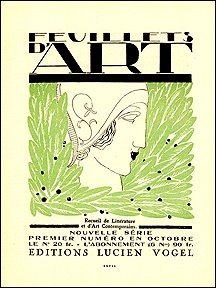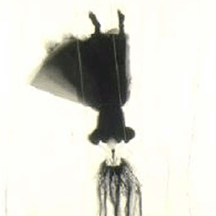
Merahi metua no Tehamana
(Ancestors of Tehamana /Ancêtres de Tehamana)
1893 Art Institute of Chicago
Gauguin's Tahitian interiors are marked by elaborate patterns on walls and fabrics; often every surface is covered a complex mix of pattern and color as with the two paintings above (
Ancestors of Tehamana) and below
(Nevermore). In these two interiors we see richly symbolic spaces made up of layers of patterns, sculptures, and natural objects such as flowers, fruits and animals.
Nevermore, O Taiti / Plus jamais (1897)
Courtauld Institute Galleries, London
Ordinary objects are shown to have with spiritual significance, such as the fan in Ancestors of Tehamana.
Gauguin's repeated use of certain objects such as mangos, which have such powerful symbolic associations with sex and fecundity makes us attentive to the mangos in the foreground of What's New? and Woman Brooding (below).
 Tahitienne (Sur La Plage) / Tahitian Women (On the Beach 1891, Musée d'Orsay, Paris
Tahitienne (Sur La Plage) / Tahitian Women (On the Beach 1891, Musée d'Orsay, Paris Interior and exterior spaces are not distinguished from each other by the use of naturalistic choices of color or light. It seems that Gauguin took his famous painting of his two women on the beach,
Tahitienne and re-created it as an interior painting in
What's New? There is very little to mark the change with the exception, perhaps, of some shading for floor boards and a hightened saturation that changes the coloring of the sand.
 Parua Api? / What's New? / Quoi de neuf?
Parua Api? / What's New? / Quoi de neuf?
(1892) Gemaldegalerie Neue Meister, Dresden In other interiors surfaces are covered--floor to ceiling with a single bright swath of color, as with the bright mango-colored floor below (
Brooding Woman) and, conversely, the world of nature is a riot of colors, sometimes arranged in ritualistic patterns. The intensity of the spiritual world associated with nature often led Gauguin to create otherworldly images of the Tahitian landscape using bold, rich but unnatural colors, as seen in the painting
The Day of the God below:
 Mahana No Atua (Day of the Gods) 1894, Art Institute of Chicago
Mahana No Atua (Day of the Gods) 1894, Art Institute of Chicago
While the world of nature can be depicted in bright unnatural patterns and colors, inner spaces are sometimes bathed in more natural hues, as in
Not Working (below). An almost identical space in
Woman Brooding is bathed in the bright colors of blue and mango -- colors of the dress worn by the woman in
Not Working. Eiaha Ohipa Not Working Pas de travail (1896) Pushkin Museum of Fine Art, Moscow
Eiaha Ohipa Not Working Pas de travail (1896) Pushkin Museum of Fine Art, Moscow
 Te Faaturuma Woman Brooding (1891)
Te Faaturuma Woman Brooding (1891)
Worcester Art Museum
Note how the canvases mirror each other in the frame of the door, the dog sitting guard, and the figure in the distance. The figures appear to be (perhaps?) the abandoned wife in the white dress catching view of her husband with another women, and the unfaithful husband returning to his unhappy wife.
To varying degrees, like Gauguin's exterior imagery, his interior spaces are fantasies. These interiors are fantasies haunted by two things: the first is Gauguin himself. As brilliant as his work is, and it is brilliant, it is also awful. Some of it is unspeakably painful. He behaved in ways that were monstrous. That his work can give testimony to this behavior is not a redemption of him as a human being but it is of him as an artist. And everyone knows those are not always the same.
Manaò tupapau /L’esprit des morts veille (1892) Albright—Knox Art Gallery.
Contes barbares, (1902) Marquises Essen, Museum Folkwang.
From his earliest arrive in Tahiti to his final death in the Marquises his artistic motivations were always twisted into his personal demons and desires and as a result he left behind him a swath of destruction in the communities where he lived. While it may be true that our current ideas about decency (whatever they may be) may not be applicable to middled-aged French men and Polynesian girls a century ago, there is no greater testament to their misery than Gauguin's own paintings. Historical materials also provide evidence that there are certain ideas about human dignity and rights that are universal.
Finally, Gauguin's Tahitian paintings are in a sense all interior spaces haunted by the reality of Tahiti itself. Tahiti was not Gauguin's tropical escape from the world -- an unspoiled paradise -- but was becoming an increasingly modernized colonial state. Tahiti was the center of French Polynesia, an important trade center. In addition, most of the native peoples had been converted to Christianity by missionaries.
 Ta Matete (We Shall Not Go to Market Today)
Ta Matete (We Shall Not Go to Market Today)
Jour de Marché (1892) Kunstmuseum BaselThe world that Gauguin paints is no less powerful for being imagined. Indeed it is all the more significant for its being the dream vision of a created by mad Robinson Crusoe driven to find the last island with a Garden of Eden until only finding populations whose decline he can only hasten with his own debauchery ultimately ending in alcholism and syphilis. This is the European avant-garde artistic statement of the primitive
par excellance. Not even Picasso could surpass Gauguin when it came to that.
the basics:
paul gauguin b. 1848, Paris; d. 1903, Marquesas Islands
National Gallery of Art, Washington DCTerminology : - Primitivism : definition from the Tate Collection online glossary
- Expressionism : definition from the Tate Collection online glossary
Additional museum collections : Additional online resources : Recommended reading :
Gauguin & Van Gogh (because it always comes back to Van Gogh): Recommended reading (available online):Just plain recommended:Lust for Life : the classic 1937 novel written by Irving Stone and based on Van Gogh's life.Lust for Life : the classic 1956 film based on Irving Stone's novel, starring Kirk Douglas, Anthony Quinn and directed by Vincente Minnelli.























